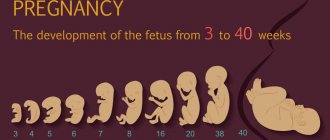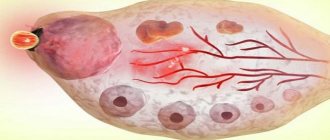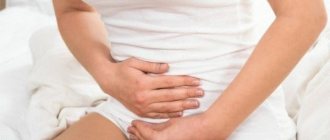Pain during ovulation
As soon as a girl begins to experience discomfort, she mentally asks herself the question: can the ovary hurt after ovulation just like that?
To answer this question, you need to understand what ovulation is. Ovulation occurs in the middle of the menstrual cycle, and is preceded by the follicular phase. This phase is characterized by the formation of an egg. Ovulation is the process of follicle rupture. This process is necessary in order to form a mature germ cell.
If we consider this process exclusively from the physiological side, then it can be confidently called a minor injury. Because after the follicle ruptures, a small lumen is formed.
It is through this lumen that the egg is released, remaining active for 24 hours. Accordingly, if she meets a sperm, fertilization will occur. If fertilization does not occur, then the so-called luteal phase begins.
This phase marks the beginning of a new cycle. During this period, there is a suppression of the synthesis of one of the hormones, which is responsible for preparing the woman’s body for pregnancy.
Progesterone begins to be produced in an enhanced mode only before menstruation. As soon as its synthesis begins with a vengeance, a new egg is formed.
It follows from this that the duration of ovulation is only 1 day. Although there are cases when ovulation lasted 2 days. But this is quite rare. During this day, pain in the ovary is considered normal.
That is, if your ovary gets sick during the period of ovulation, there is no reason to worry. After all, as we have already found out, during ovulation the ovary receives a slight injury. This is what causes pain.
However, within 24 hours the pain should completely disappear. If this does not happen, then this is a reason to immediately seek help from an antenatal clinic.
You can even call an ambulance if the pain becomes unbearable or is accompanied by bleeding.
Ovarian pain after ovulation
Pain in the ovaries during pregnancy. Video
Many women in the 1st and 2nd trimester of pregnancy noted a tingling sensation in the ovary - painful sensations of an aching nature, and sometimes sharp, severe stabbing pains. But is tingling in the ovary a sign of pregnancy, or is it a symptom of some dangerous disorder occurring in the body that requires immediate medical attention? To answer this question, we need to understand what causes can lead to pain in the pelvic organs.
The main causes of tingling in the ovaries:
- Sprain
- along with the growth of the fetus, changes occur in the uterus, which increases in volume and rises higher, and after it the neighboring organs rise. That is, when a “knowledgeable” woman shares her experience and says that if the right (left) ovary colitis is a sign of pregnancy, in fact we are talking about pain in the place where this organ is usually located. It's not there, but there are tense, stretchy ligaments that support the uterus; - Adnexitis
(inflammation of the ovaries) or oophoritis (inflammation of the appendages), against the background of which conception occurred. This condition of the female body requires constant monitoring by a gynecologist, as it can cause miscarriage or fetal death. - Radiating pain
from the intestines down the abdomen. After conception, a woman needs to carefully monitor her diet and try to eat foods so that her stools are soft and regular. If this cannot be achieved or the pain is prolonged, then consultation with a specialist is required. - Benign/malignant neoplasms
(cysts/tumors) of the ovaries can cause not only a slight tingling sensation, but also severe pain. Women with this diagnosis are usually under the constant supervision of doctors in the gynecological department of the hospital for almost the entire period of pregnancy. - Ectopic pregnancy
. If you have severe pain in the lower abdomen after conception, and you haven’t gone to an ultrasound or to a gynecologist yet, then it’s time to do it, at least in order to weed out an ectopic pregnancy, and not put yourself in a stressful state.
Natural causes of pain in the ovaries
The reasons why the ovaries hurt during ovulation lie in the physiological characteristics of the body. In the first days of menstruation, women begin the process of maturation of germ cells - follicles, which occurs precisely in the ovaries. During the menstrual cycle, one such cell matures, but sometimes deviations from the norm occur. A single follicle is called dominant, and after 2 weeks from the beginning of the cycle, it turns into a kind of bubble with liquid. It is quite large in size, since the egg is stored inside it.
Because the egg needs to travel through the fallopian tube to the uterus, the follicle has to burst. It is the process of rupture and release of a mature egg that is called ovulation. The reason why the ovary hurts during ovulation lies in the rupture process itself: the walls of the vesicle consist of living tissue that requires blood to function. This means that when the walls rupture, damage to the blood vessels occurs, which causes bleeding. If small capillaries were damaged, then nothing bad happens - pain in the ovary after ovulation in this case is extremely weak or absent altogether.
However, when large blood vessels rupture, heavy bleeding begins in the abdominal cavity, resulting in irritation of the peritoneum. In most cases, the reason why the ovary hurts after ovulation is a consequence of the work of the procreation mechanism inherent in nature. Sometimes pain can occur even in the absence of bleeding. This symptomatology most often occurs in women with an extremely low pain threshold or experiencing constant pain during menstruation.
You can determine that ovulation is the cause of the pain based on several symptoms:
- Increased libido. The reproduction mechanism created by nature forces a woman to urgently look for a partner during the period of ovulation.
- The appearance of liquid discharge. They usually appear a few hours before and go away only after a few days.
- Change in color of discharge to reddish or pale pink.
Important! If in the middle of the menstrual cycle there is discharge, the consistency of which contains blood, you should urgently contact a specialist.
Natural causes of ovarian pain
The process of egg maturation occurs in the ovaries in turn. On average, ovulation occurs 14 days before your period. At this time, the reproductive cell leaves the ovary, breaking through its wall. A small wound forms in the shell, which gives unpleasant sensations.
The egg ruptures the ovary, causing nagging pain
Pulling on the left ovary
If the left ovary pulls after ovulation, it means that at this stage it has done its job. If the right one, then he was responsible for the maturation of the cell this month. The ovary worked hard to create an egg, and finally received a wound. It is clear that he expresses his attitude in the form of unpleasant sensations.
The egg then enters the fallopian tube and, moving towards the uterus, awaits fertilization. This is how it happens:
If the left ovary is pulled after ovulation, pregnancy is a completely reasonable explanation. If pain occurs 4–7 days after ovulation, we can talk about a successful conception: the embryo has reached its destination and attached to the wall of the uterus. At this time, pink vaginal discharge is also possible, which passes quickly and without a trace.
From the above, we conclude that if the left ovary is pulling after ovulation, there can be two reasons, quite natural: the ovulation process itself or the occurrence of pregnancy (depending on the period of onset of pain). In this case, listening to your feelings is very important. This helps a woman find out the day needed to conceive, or warn against unwanted pregnancy.
Pulling the right ovary
Having decided to clarify the question with “friends in misfortune”, if the right ovary is pulling after ovulation, the forum of young mothers and those who want to get pregnant will give you the same answer.
Pulling the ovary - reviews from the forum
Is it normal to feel pain during ovulation?
Ovulation occurs as follows: a mature egg breaks through the follicle and begins to move into the uterine cavity along the fallopian tube. Some women recognize this process by characteristic sensations - after ovulation, the lower abdomen and ovary pull.
The release of the egg is accompanied by minor trauma - the wall of the ovary is damaged, and a small cavity remains at the exit site. This is what causes the discomfort. Such symptoms are completely natural and do not require treatment.
But the ovary can hurt for other reasons. You should consult a doctor immediately if:
- body temperature rises;
- suspicious discharge appears;
- weakness and dizziness are observed;
- concerned about the presence of severe stabbing or cutting pain;
- unpleasant sensations persist for a long time.
In addition, pain in the second half of the cycle may be signs of pregnancy. This also cannot be called the norm - they often indicate the presence of pathology (fibroids, ectopic pregnancy, cyst, spontaneous abortion).
Sometimes a woman may notice pain in her ovaries before her period. This condition may not always indicate the presence of pathology, but we recommend reading additional information on this topic.
Causes of pain in the ovaries associated with the phases of the menstrual cycle
Throughout the entire menstrual cycle, a woman’s reproductive organs and hormone levels change. Likewise, the ovaries are constantly undergoing changes.
During ovulation
Some women do not feel signs of ovulation. Others, on the contrary, say that the pain in the ovarian region during this period acquires a stabbing, pulling character. Brief discomfort does not pose a threat to the body and does not require any treatment. This is due to the rupture of the follicle, which releases a mature egg for conception. Also, during ovulation, the ovary may prick due to exacerbation of inflammatory processes in the pelvic organs (adnexitis, oophoritis). At the same time, after training, stress, or lifting weights, unusual discharge is observed. To reduce pain and relieve discomfort in the lower abdomen, a woman is recommended to take analgesics (Spazmalgon, No-Shpa). If after taking a painkiller the ovaries still hurt, then the reason is not ovulation. The patient needs to consult a doctor, be examined, and begin appropriate treatment.
Remember! Each woman experiences ovarian pain differently. It all depends on age, chronic diseases, pain threshold and other individual characteristics of the body. However, if there is shooting in one of the appendages for a long time, and nausea or fever is observed, the woman urgently needs to see a doctor! Such symptoms may indicate either a cyst or ovarian torsion.
During your period
It is considered normal if pain in the ovaries appears a few days before the start of menstruation and becomes stronger during it. On the first day, women feel mild nausea and dizziness. The nature of the pain is twisting, stabbing, aching. There are cases when, towards the end of menstruation, a woman begins to vomit. This is a rather rare symptom of menstruation, therefore, if such a “side effect” has not been observed before, you should undergo a gynecological examination and ultrasound diagnostics.
Lifting weights, overwork, disturbances in the psycho-emotional state, and constant stressful situations lead to an increase in pain and a worsening of a woman’s general well-being. What can be done in this situation and how to reduce the pain? No treatment is required for painful periods. A woman just needs to take a painkiller (for example, Tamipul) or apply a warm heating pad to her lower abdomen. Herbal infusions and decoctions are good for relieving pain in the ovaries during menstruation. If it is summer at this time, you can collect fresh leaves of the hogweed, red brush, chamomile flowers, or simply purchase ready-made herbal infusions at the pharmacy.
During menopause
Menopause is accompanied by a series of hormonal changes in the body due to the lack of bleeding. She appears individually. Menopause occurs at the age of 45-50 years. The onset of menopause can provoke pain in the ovaries, but such pain does not last long. During this period, a woman is more susceptible to infections and viruses. If the discomfort in the lower abdomen does not go away for a long time, painkillers do not help, and the pain only grows and intensifies, you need to urgently contact a gynecologist.
The following are the causes of pain in the ovaries after menopause:
- inflammation;
- cyst;
- malignant tumors.
Pain in the ovaries is accompanied by changes in vaginal tissue, frequent urination, sweating, impaired bowel movements, and increased body temperature. Therapy depends on the nature of the complaints and the identified cause of discomfort.
Functions of the ovaries
The menstrual cycle is an individual phenomenon. The duration and processes occurring in it help in the birth of a new life, and also show how normally the female body and sexual function work.
The cycle is divided into two phases. The first lasts from the beginning of menstruation until the day of ovulation. It is characterized by the growth of a liquid bubble in one of the ovaries, in which the egg matures under the influence of the hormone estrogen. As soon as this period ends, ovulation occurs. The follicle bursts and the reproductive cell comes out. It is during this period that a woman may feel that her ovary is tingling. From this moment the second phase begins. At the site of the wound, the corpus luteum begins to grow in the ovary. This is a normal process due to which progesterone is produced. The latter is responsible for conception and the further course of pregnancy.
If fertilization does not occur within 24 hours, the egg dies, the process ends with menstruation, after which the cycle repeats. In case of a successful outcome, the embryo descends into the uterus and the embryo develops if it is fixed to the wall.
The ovaries play an important role in the menstrual cycle
As you can see, the ovaries are responsible for the maturation, and timely, of a full-fledged cell. They contain many identical liquid bubbles, one of which suddenly bursts forward and begins to develop intensively, in which the germ of future life begins to grow.
Intensity and nature of pain
These include:
- Impact of various external unfavorable factors.
- Presence of gynecological diseases.
- Physical well-being.
The pain can be barely noticeable or, on the contrary, severe, capable of depriving a woman of the opportunity to lead a normal life. Both glands cannot be sick at the same time, since only one egg matures once a month. This process takes place in one of the ovaries.
Pulling on the left ovary
This means that the egg came out of it and fertilization occurred. After a follicle ruptures, women often experience some discomfort.
Therefore, there may be two reasons for this:
- The process of ovulation itself.
- Fertilization.
Pulling the right ovary
When the egg matures in the right appendage, discomfort appears on this side. If they occur 4 days or a week after ovulation, it means the woman has become pregnant. The presence of pinkish discharge should not be a concern. They will quickly disappear.
ATTENTION! An incorrect lifestyle can lead to increased pain. Unfavorable factors include the presence of bad habits, constant stress, unbalanced diet
If the ovary tingles only from time to time and not too severely, this may indicate
Sharp spasms should alert you. They often accompany disturbances in the functioning of the reproductive organs.
Aching sensations can be completely normal for the period after ovulation. If they cause concern, the woman may have developed adnexitis under the influence of an infection.
Tangible discomfort should alert you. If the unpleasant sensations do not go away, but on the contrary, increase, you should definitely see a specialist.
ATTENTION: Sharp, severe painful sensations may indicate a cyst rupture. The reason for this situation is often excessive physical activity, heavy lifting, rough sexual intercourse
Duration
Discomfort during this period
. If it persists for a longer period of time, it may indicate a problem.
Pain during ovulation, which is localized in the ovary, is a common symptom. These pains may be a consequence of physiological processes that are accompanied by the formation of a wound during the release of a mature egg. However, pain sometimes also accompanies various pathological conditions.
It is noteworthy that the nature of pain in the ovaries after ovulation is different. The pain syndrome is determined by the individual characteristics of the woman. After ovulation, either one or both ovaries may hurt. The pain can be mild or severe.
The pain is usually localized on the right or left. Both ovaries should not hurt, since the maturation of the follicle and egg is noted in one of the ovaries. Bilateral pain is a reason to consult a doctor.
Nagging pain on one side of the abdomen is considered a normal condition. The pain is associated with the release of a mature egg from the follicle, which is accompanied by the formation of a wound.
Ovarian aches
If the ovary hurts slightly, there is no cause for concern. Irradiation of lower back pain, as well as its intensification, may indicate the development of an inflammatory process. You should definitely contact a specialist.
The appearance of discomfort associated with tingling usually indicates a disruption in the functioning of the organs of the reproductive system.
Attention! Pain after ovulation in the ovarian area should not bother a woman for more than two days. Dangerous symptoms include bleeding, fever
If the examination shows that the ovary is contracting after ovulation and this is not accompanied by any pathology, then there is no need for treatment. The best way out is to endure this period. A bath with warm water or a heating pad will help you relax and relieve pain. These methods can only be used when there is no inflammatory process.
Why does the ovary hurt or tingle?
At the moment of ovulation, a small wound forms on the wall of the ovary, the appearance of which is caused by the release of the cell and the rupture of the vesicle. She makes herself known, what many women feel. This is expressed by the manifestation of a slight nagging pain in the lower abdomen, in which case they say “the ovary tingles after ovulation.” Such pain is usually mild and short-lived; some may not even feel it.
A mature egg leaves the ovary, which may cause tingling
By the tingling sensation, you can determine in which of the ovaries the process is occurring. It is necessary to calculate the day of the expected release of the egg according to your menstrual cycle and begin to listen to the signs of the body. If the left ovary tingles during or after ovulation, it means that at this stage the action of cell formation took place in it. And when it hurts or pulls on the right side, it means work was done here.
Tingling in one of the ovaries - what could be the reasons?
If the tingling of the ovary turns into severe pain or bothers you for more than two days, there may be other reasons:
- the presence of any inflammatory diseases;
- disruption of hormonal levels in the body;
- incorrect location of the uterus with appendages;
- pathology of development of female genital organs;
- irregular menstrual cycle, etc.
In this case, you need to visit a medical facility to identify the cause. This is the case when it is better to be safe than to get sick.
So, if the ovary tingles during or immediately after ovulation, you should pay attention to this to identify a favorable period of conception. But it should be remembered that pain perception in this case is short-term and should disappear upon the onset of the second stage of the cycle. Otherwise, do not forget to visit your doctor. You should always take care of your health.
Characteristic discharge during ovulation
When the lower abdomen pulls after ovulation, specific discharge is also observed, characterized by the following moments:
- The mucus is liquefied due to the action of the hormone, which “splashes out” after the rupture of the bubble. Before this, the cervical mucus was very thick and blocked the entrance to the uterus to prevent the passage of sperm in the absence of a cell here.
- At the moment the cell enters the genital tract, the mucus changes its structure and characteristics, creating an optimal environment for the movement of male cells.
- The mucus is thick, transparent, viscous. There is an abundance that is not typical for other periods of the cycle. Therefore, the woman immediately understands that ovulation has arrived.
- Due to the rupture of the follicle, shades of brown may appear in the mucus. If there are only a few of them and they disappear after a couple of days, the process went well. If the shades are bright, bloody, and last a long time, you should immediately visit a doctor.
Pulling in the lower abdomen after ovulation - what is it?
Knowing the listed features, we understand the causes of pain directly at the moment of ovulation. But there are times when it comes at a later date, for example, even on the 5th day after ovulation, it pulls in the lower abdomen. Can an ovarian wall rupture be felt for so long? Probably not
The reason here may lie in a more interesting and important moment for the woman - probably, the process of attachment of the embryo to the uterus has occurred. For some, this process is felt 4-7 days after fertilization
If you have pain, which can be described as mild, nagging, you can expect slight discharge of a pinkish tint. They should pass quickly, no more than a day.
Therefore, if after ovulation the lower abdomen feels tight for a week, you should take care of buying a test and, after waiting another week, analyze the presence of conception. You can also wait for a new cycle and check if your period comes. If you want to find out the cause earlier, you can visit an ultrasound. The doctor will be able to answer the question immediately, because he will clearly see the presence of an embryo.
When should you be concerned?
We looked at the typical, natural reasons why the lower abdomen feels tight during or on the 4th day after ovulation. But there are times when this is not the norm. Therefore, you need to check for other characteristics. You should be concerned if you have the following:
- temperature increase;
- the pain lasts constantly and is not felt as usual (in other cycles);
- sensations do not change character, continue to be felt for more than 12 hours;
- nausea, vomiting.
Of course, these reasons are very biased. We know that a slight increase in temperature and nausea are also symptoms of pregnancy. But at such an early stage, they are unlikely. In any case, an increase in the indicator on the thermometer is alarming - this is the first sign of a disease or infection in the body. It's better to play it safe and visit a doctor. After all, such symptoms, provided that 2-3 days after ovulation the lower abdomen pulls, may indicate one of the following reasons:
- inflammatory process in the genital tract;
- hormonal disorders;
- tumor initiation;
- the presence of pathology, improper functioning of the female function;
- disturbances in the location of the uterus and appendages
Important If the lower abdomen feels tight the day after ovulation, there is no need to worry. If the pain does not stop, a doctor’s consultation will not be superfluous.
If a disorder or disease occurs, it is better to treat it immediately.
If a week after ovulation the lower abdomen feels tight or at another point in the cycle, i.e. 100% not related to the cell exit process, you should visit a doctor immediately. Such symptoms may indicate very unpleasant diseases and disorders:
- Rupture of the wall or tissue of the ovary. This is possible with excessive physical activity, sudden lifting of weight, and even due to rough sexual intercourse.
- Inflammation of the genital tract, cervix or ovaries due to exposure to microbes and pathogenic bacteria.
- The appendages are inflamed.
- An ovarian cyst ruptured.
If you have abdominal pain a week after ovulation, you should consult a doctor.
The pain can be severe and even sharp, radiating to the lumbar region.
So, if a woman has a tightening in her lower abdomen after ovulation, this can mean completely different processes occurring in the body. You need to listen carefully to your feelings and, if necessary, do not put off visiting a doctor.
When is there cause for concern?
However, there are situations when you should sound the alarm in advance. For example, if the left ovary hurts after ovulation for a week or more. This may be a symptom of the following situations and diseases:
- the presence of an inflammatory process;
- hormonal disorders;
- the occurrence of a tumor (benign or malignant);
- pathology of development of the female body;
- incorrect location of the appendages and uterus;
- Irregular menstrual cycle.
If the ovary hurts for a week after ovulation, you need to consult a doctor. If the right ovary hurts after ovulation (or the left), you need to listen to other symptoms:
- an increase in temperature is the first sign of a malfunction of the body or the presence of an infection;
- nausea, vomiting;
- the pain is constant;
- Duration of pain over 12 hours.
In this case, you need to immediately consult a doctor and look for the cause of the malaise.
So, we figured out why the left ovary pulls during ovulation. If this happens at another period of the cycle, an inflammatory process or other not very pleasant reasons are possible:
- rupture of an ovarian cyst;
- apoplexy – spontaneous rupture of ovarian tissue, which occurs during exertion, lifting weights, as well as rough sexual intercourse;
- adnexitis - inflammation caused by microbes;
- oophoritis - inflammation of the appendage.
You should not leave it to chance if, in addition to the nagging pain in the ovary, there are other symptoms.
Therefore, if the right ovary pulls after ovulation for a week or in the middle of the cycle, and also radiates to the lower back and is accompanied by other symptoms, you should not self-medicate. You should immediately visit a doctor to avoid a number of complications and infertility.
How you can help
Treatment is prescribed after an accurate diagnosis has been established. If the nagging pain was provoked by adnexitis, then the patient is advised to take Metronidazole, which has an antimicrobial effect. For this disease, the woman is also prescribed Erythromycin.
With oophoritis, you also cannot do without antibacterial drugs. Most often, the doctor prescribes a course of Doxycycline, Amoxiclav, Trichopolum, Negram and Azitrocin. Additionally, a woman may be prescribed vitamin preparations that contain vitamins E and C. Among painkillers, preference is given to Spazmolgon and Tempalgin.
Taking any medications is allowed only under the supervision of a doctor.
Among folk remedies, preference should be given to decoctions of yellow clover, coltsfoot and round-leaved wintergreen. The use of herbs also requires prior approval from a gynecologist, since each of them has its own contraindications.
If the root cause of pain during ovulation was an inflammatory process, the woman is recommended to take mud baths. Hot douching is also very useful.
Let's sum it up
I have described five working methods that will help every planning woman, long before the delay, easily and quickly detect the beginning of her pregnancy at home.
These are the main and most frequently repeated symptoms. They are described by numerous stories of experienced mothers on forums, and doctors talk about them. I studied each of them - thanks to them, I knew very early that my dream had finally come true. Try to understand your body and “feel” the birth of a new life!
Advice(!) The desired pregnancy can come very quietly, without signs and special sensations, so do not rush to get upset if you do not see the described manifestations in yourself. In this case, your assistant will be basal temperature and hCG tests from 8–11 DPO.
My pregnancy tests from days 9 to 16 after ovulation
I wish you to see the second strip as soon as possible!
Checklist for early pregnancy detection
- Light spotting from 7th to 10th DPO.
- The cervical fluid a week before the start of menstruation is mucous, jelly-like, may be streaked, more abundant than usual.
- Thrush (candidiasis) has started.
- Aching pain, tingling in the lower abdomen, pulling in the lower back for a short period or several days.
- BT dropped for one day, and then returned to normal levels or became even higher.
- The third phase has been emerging on the graph for the second day already (above the average BT in the second phase by 0.1-0.3°).
- A few days before the start of menstruation, the basal temperature did not go down as usual, but remained elevated.
- The average BT in the second phase after the 7th DPO is already three days higher than usual.
- Sudden changes in mood, tearfulness, weakness, apathy.
- Very sensitive, full breasts, especially the nipples.
- Aversion to smells and some familiar foods.
- It is unclear why the headache hurts (monotonously or just splitting).
- Cold or feeling of a cold with a temperature of 37-37.5, nasal congestion and chills.
- Indigestion: nausea/dizziness, heavy stomach, belching, drooling, unpleasant unusual taste in the mouth, bloating, constipation (all or some of them).
- Diarrhea for no apparent reason.
Are you seeing these signs? So it's time to take an ultra-sensitive pregnancy test!










